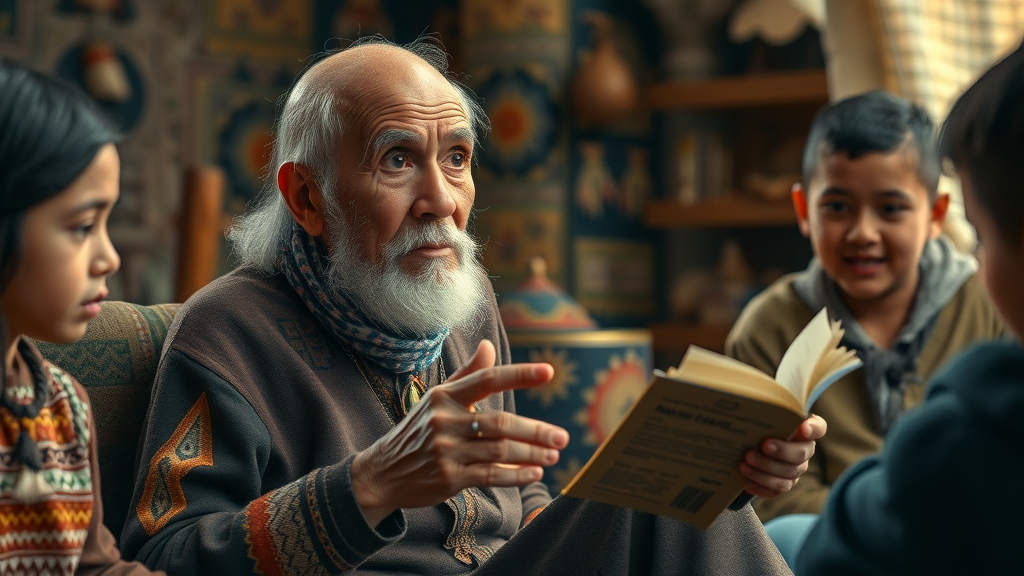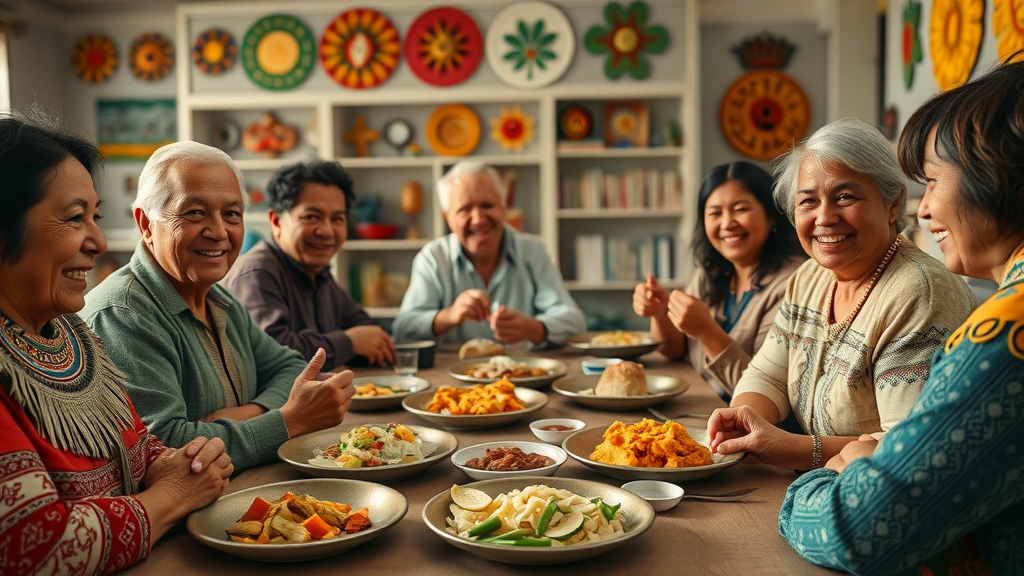Did you know that over 90% of the world’s 7,000 languages are spoken by indigenous people? Yet, thousands are at risk of disappearing within a generation. This striking reality highlights why cultural awareness isn’t just a buzzword—it’s the foundation for survival, respect, and resilience in today’s rapidly changing world.
In this opinion piece, we'll delve into the often-overlooked impact of cultural awareness, especially how it shapes the lives of indigenous peoples, redefines community, and can spark a personal and societal breakthrough you didn’t realize you needed. Let’s challenge misconceptions, celebrate breakthroughs, and discover practical steps you—and your community—can take.

Did You Know? The Uncomfortable Truth About Cultural Awareness
Cultural awareness is a concept widely praised but often misunderstood. Many assume it’s simply about learning a few phrases or enjoying a diverse array of foods. However, the truth is much deeper—and sometimes uncomfortable. Across the globe, a lack of cultural awareness continues to fuel misunderstanding, reinforce stereotypes, and create social division, particularly for indigenous people who face ongoing exclusion from national narratives and policy decisions.
In a time when the world celebrates national day and international day events on an unprecedented scale, the uncomfortable truth emerges: without genuine engagement and the willingness to confront historical inequalities, these days can become empty gestures. The real realization comes from understanding cultural awareness as a lived experience—one that directly impacts the mental health, human rights, and opportunities available to marginalized communities, especially indigenous peoples. Creating authentic change involves raising awareness, challenging biases, and prioritizing inclusion over tokenism.
How a Lack of Cultural Awareness Impacts Indigenous Peoples Worldwide
For indigenous peoples , the consequences of cultural ignorance go beyond social slights. In many regions, a lack of understanding and respect for indigenous cultures—including their indigenous language , rituals, and traditions—undermines the preservation of cultural heritage. The threat intensifies when policymakers, educational institutions, and even well-intentioned organizations fail to incorporate indigenous voices. This erasure contributes to deep social inequalities and a loss of identity, with ripple effects that impact mental health, sustainable development, and collective pride.
Consider the example of Australia’s National Day ; in recent years, indigenous people have used the occasion to highlight the complexities of national celebrations that overlook historical injustices. Without meaningful cultural awareness, “heart day,” heritage month, or equality day risk becoming performative rather than transformative. To shift this pattern, institutions and individuals alike must recognize the real effects: from barriers in education and healthcare to the silencing of indigenous stories in mainstream media. This realization is crucial for building a foundation of respect, empathy, and collaboration in any community.
Why Cultural Awareness Matters in 2024: More Than a Trend
It’s easy to think of cultural awareness as part of the latest diversity trend, but in 2024, its relevance transcends mere trends. Today’s interconnected world is shaped by migration, globalization, and rapid technological change, making it more important than ever to understand and honor the diverse realities of people—including indigenous people. Genuine cultural awareness isn’t about superficial gestures. It’s a transformative commitment rooted in respect, empathy, and a willingness to challenge preconceived beliefs.
The global momentum around international day , pride month , and heritage month observances shows a rising demand for authentic engagement. These events are more than boxes to tick—they’re calls to action that require us to integrate cultural understanding into everyday decisions and policies. In this context, cultural awareness is not a fleeting fad but an urgent necessity for advancing human rights, building stronger mental health systems, and ensuring equitable development goals for all. The impact is especially profound for indigenous peoples, whose recognition and representation shape the collective well-being of the entire community.
The Relationship Between Indigenous People and Cultural Awareness
At its core, the relationship between indigenous people and cultural awareness is foundational. Indigenous communities have always been stewards of cultural richness—carrying forward traditions, oral histories, and sustainable practices honed over centuries. However, modern society’s grasp of cultural awareness often fails to account for the specific challenges and contributions of indigenous peoples. When true understanding is absent, not only are indigenous voices marginalized, but the wider society misses opportunities for learning and growth.
Elevating cultural awareness in relation to indigenous people means making space for genuine dialogue, supporting indigenous language revitalization, and integrating indigenous knowledge into climate change solutions, education reform, and community health initiatives. Recognizing the power dynamic at play, cultural awareness becomes a tool for justice and self-determination—not just for indigenous peoples, but for every member of society seeking to thrive in a diverse, interconnected world.
Social division and misunderstanding: Increased stereotypes and discrimination create barriers in everyday interactions.
Barriers to inclusion for indigenous peoples: Greater challenges in accessing opportunities and participating fully in society.
Missed opportunities for growth and collaboration: Communities lose out on innovation and knowledge shared by diverse groups.

How Cultural Awareness Drives Positive Change in Communities
Communities with high levels of cultural awareness are better positioned for success—socially, economically, and emotionally. When individuals and organizations acknowledge and respect the cultural identities of all people, especially indigenous peoples , a newfound sense of belonging emerges. This sense of inclusion is vital for unlocking the full potential of any society, as highlighted in case studies across the world.
Positive change driven by cultural awareness is evident in stronger community bonds, increased empathy, and more robust communication. Examples range from improved mental health outcomes to innovative solutions for local challenges as a result of indigenous knowledge-sharing. As more nations celebrate equality day , national black business month , and national civility month , cultural awareness becomes the linchpin for unity, progress, and collective pride.
National Day and International Day: Elevating Indigenous Peoples Through Cultural Awareness
Both national day and international day celebrations are powerful opportunities to showcase and support indigenous cultures. When thoughtfully organized, these events can boost cultural awareness, amplify indigenous voices, and spur action for genuine change. For instance, the United Nations’ International Day of the World’s Indigenous Peoples raises awareness about indigenous people’s rights and advocates for equitable policies. Such days are crucial for educating the public, inspiring solidarity, and honoring the unique identities of indigenous peoples.
However, the impact of national days fluctuates based on intent and participation. When deeper engagement is prioritized, national day becomes a catalyst for learning, challenging stereotypes, and advancing the well-being of indigenous peoples. Reimagining these observances through the lens of cultural awareness ensures that dialogue continues beyond a single day—informing policies, enhancing mental health resources, and creating safe spaces for intergenerational exchange and growth.
Celebrating Indigenous Language: A Key Pillar of Cultural Awareness
Preserving indigenous language is not simply a matter of academic interest—it is a vital component of cultural identity and resilience. Increasingly, communities are recognizing the importance of integrating indigenous language initiatives within schools, local government programs, and virtual learning platforms. According to recent data, more than 40% of indigenous languages are at risk of extinction. Every language lost represents a loss of unique knowledge systems and cultural perspectives, often cultivated over millennia.
Language revitalization is a powerful tool for cultural awareness, as seen in Canada’s support for indigenous language education paired with national days of recognition. These efforts celebrate pride month-like moments but focus specifically on indigenous legacies. By supporting the teaching of indigenous languages, societies enhance empathy, nurture indigenous pride, and secure the transmission of precious cultural heritage to future generations.

Building Bridges: Personal Lessons From Embracing Cultural Awareness
Embracing cultural awareness cannot be accomplished in isolation; it requires engagement, humility, and a willingness to listen. Personal growth often begins when individuals challenge their assumptions and choose to learn directly from indigenous people. Whether through participating in community events, attending workshops, or simply sharing a meal during heritage month, every step builds bridges and fosters trust.
These lessons extend beyond professional environments. By incorporating practices such as recognizing the traditional lands on which we live, supporting indigenous business month initiatives, and uplifting indigenous voices in everyday conversations, we cultivate empathy and deepen connections. The true breakthrough comes from seeing cultural awareness not as an obligation, but as a life-long journey—evolving with every conversation, story, and new understanding.
"Cultural awareness is not a checkbox—it’s a worldview shift that opens doors to understanding and respect."
First-Hand Perspectives: Learning From Indigenous People
The most valuable insights into cultural awareness often come from engaging with indigenous peoples themselves. Listening to first-hand accounts of their experiences illuminates both the challenges faced and the strengths maintained across generations. These narratives reveal the profound impact of inclusivity, the struggle for recognition, and the transformative power of small acts—like learning an indigenous word or supporting a local indigenous artist.
Case studies have shown that when non-indigenous members participate in indigenous-led celebrations—such as national day or an indigenous language event—misunderstandings decrease, mental health outcomes improve, and stereotypes are more effectively dismantled. Ultimately, these connections seed empathy, unlock new perspectives, and show that cultural awareness is a living practice, constantly shaped by real stories and real people.
What You'll Gain by Deepening Your Cultural Awareness
By investing in cultural awareness , individuals and organizations unlock a wealth of personal and communal benefits. Beyond the immediate impact on diversity and inclusion, deep cultural understanding fosters empathy, enhances communication, and opens previously inaccessible pathways for collaboration and innovation. For businesses, these benefits translate into a competitive edge—one that honors employees’ identities and resonates with increasingly diverse markets.
On a societal level, strong cultural awareness supports sustainable development goals, improves relationships with indigenous peoples, and empowers future generations to act with compassion and knowledge. Inclusive spaces created by actively learning about indigenous cultures and taking part in heritage month activities result in resilient, cohesive communities that are able to meet today’s global challenges head-on. The journey to cultural awareness is ongoing—but every step brings you closer to deeper connections, greater understanding, and more meaningful progress.
Enhanced empathy and social cohesion
Improved communication in diverse settings
Stronger relations with indigenous communities
Unlocking new perspectives and opportunities

Case Studies: How Cultural Awareness Created Breakthroughs
Examples of Cultural Awareness in Action |
||
Initiative |
Community |
Impact on Indigenous Peoples |
|---|---|---|
National Day Celebrations |
Australia |
Boosted awareness of indigenous cultures |
Indigenous Language Revitalization |
Canada |
Improved preservation of native languages |
International Day of the World's Indigenous Peoples |
Global |
Promoted inclusion and policy reforms |
These case studies demonstrate real-world breakthroughs made possible by prioritizing cultural awareness. Each example reveals that when initiatives go beyond superficial efforts and truly include indigenous voices, communities witness greater unity, creativity, and sustainable development. More importantly, these stories spotlight how celebrating diversity on days like national day or international day can translate into lasting change, not just symbolic gestures.
The promotion of cultural heritage, integration of indigenous language in education, and support for business month programs in indigenous communities are more than annual campaigns—they’re ongoing commitments with measurable results. By seizing these opportunities for engagement, organizations, government bodies, and individuals create momentum for future breakthroughs rooted in unity, justice, and mutual understanding.
People Also Ask
Why is cultural awareness important for indigenous peoples?
Cultural awareness enables indigenous peoples to maintain their traditions, languages, and identities. It fosters respect across communities, driving social inclusion and preserving critical cultural heritage. When embraced by broader society, it reduces inequality and ensures that indigenous voices are heard in discussions shaping policy, education, and mental health support.
How does cultural awareness benefit society as a whole?
Societies that prioritize cultural awareness are more cohesive, innovative, and resilient. Understanding diversity helps address social inequalities and supports collaboration among all peoples, fostering environments where different perspectives are not only tolerated but celebrated. Ultimately, this leads to thriving communities and stronger connections at every level.
What role do events like national day and international day play in promoting indigenous peoples’ rights?
National day and international day events bring attention to issues faced by indigenous peoples, celebrate their cultures and languages, and advocate for fairer policies and protections. These events are key to raising public awareness, sparking dialogue, and encouraging concrete action from governments, organizations, and community members alike.
Overcoming Misconceptions About Cultural Awareness
Debunking Myths: Cultural Awareness Is Not Political Correctness
A common misconception is that cultural awareness is simply another form of political correctness. In reality, cultural awareness is about creating genuine understanding, not just avoiding offense. The most successful organizations and communities recognize that embracing cultural awareness leads to real-world benefits, such as improved mental health outcomes, more effective teamwork, and stronger relationships between non-indigenous and indigenous peoples alike.
Actively integrating cultural knowledge—rather than relying on stereotypes—allows for meaningful progress on issues like human rights, gender equality, and sustainable development. This approach does not dilute societal values but strengthens them, ensuring broad representation during events like pride month, equality day, or national civility initiatives. In essence, cultural awareness sets the stage for authentic, respectful dialogue and shared transformation.

Dispelling Stereotypes About Indigenous Peoples and Cultural Awareness
Persistent stereotypes about indigenous peoples hinder cultural awareness and stymie progress. True understanding demands moving beyond reductive images and engaging with the full complexity of indigenous cultures, beliefs, and contributions. When communities, schools, and businesses rewrite these narratives, they pave the way for a more inclusive society.
Initiatives like national black business month, climate change summits inclusive of indigenous voices, and heritage month celebrations that center indigenous stories serve to educate the public and inspire new generations. Raising awareness requires ongoing dialogue and active participation, ensuring that indigenous people are recognized not as relics of the past, but as vital contributors to our shared future.
Your Role in Advancing Cultural Awareness: Practical Steps
Engage with indigenous communities on national day and international day: Participation enhances understanding and solidarity.
Learn and respect indigenous languages: Small efforts in daily conversation can have profound effects.
Support educational programs and initiatives: Advocate for inclusive curricula and resources in local schools.
Amplify indigenous voices in your organization: Create spaces for indigenous leadership and representation.
Taking action doesn’t require a grand campaign. Sometimes, the most powerful steps involve humility—a willingness to listen, learn, and adapt. By educating yourself on indigenous histories, acknowledging the stories shared during heritage month, and supporting sustainable business practices, each person contributes to an ongoing cultural shift that benefits all.

Frequently Asked Questions on Cultural Awareness
How can I become more culturally aware in my daily life?
Start by actively seeking out information about different cultures—read books, attend events like national day or heritage month, and engage in meaningful conversations with people from diverse backgrounds. Stay curious and listen with empathy, recognizing your own biases and striving to learn directly from indigenous peoples and other minority communities.
What resources support learning about indigenous peoples’ cultures?
Many universities and museums offer online materials, documentaries, and virtual exhibits on indigenous cultures. Local indigenous organizations frequently host public workshops and events. Additionally, government and non-profit agencies often provide language learning tools and curricula centered on indigenous languages, making it easier to access authentic knowledge.
How do schools teach cultural awareness today?
Modern education integrates cultural awareness through inclusive curricula, diversity days, and partnerships with indigenous elders. Schools increasingly emphasize the importance of indigenous languages and facilitate student engagement during national day and international day activities. These efforts encourage critical thinking about stereotypes and prepare students to be respectful global citizens.
In Summary: Has Cultural Awareness Been Your Missing Breakthrough?
Reflecting on Indigenous Peoples, National Day, and the Future of Cultural Awareness
"True transformation only begins when we embrace cultural awareness not just as a practice, but as a core value."
Action speaks louder than intention. Choose to seek out the perspectives of indigenous peoples, support cultural awareness initiatives on national day and international day, and use your voice to foster genuine inclusion. The breakthrough you’ve been waiting for is within reach—start your journey today.
Ready to Take Action on Cultural Awareness?
Contact us today to learn more about embracing cultural awareness: call 07549988991, email gary@weacton.com
Title: "Indigenous Peoples and The Power of Cultural Awareness" — A short educational video highlighting the impact of cultural awareness initiatives, clips of indigenous celebrations, interviews, and examples of positive change in communities.
 Add Row
Add Row  Add
Add 



Write A Comment